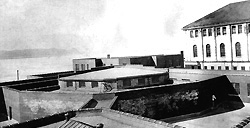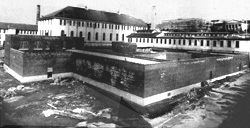|
Five:
THE ELECTRIC CHAIR ( excerpts )
. . . . New York State was in search of a humane method of execution. On June 4, 1888, Gov. Daniel B. Hill signed a bill authorizing the use of the electric chair. The jolt of electricity from the electric chair rendered the victim unconscious in less than a second, before any pain could be felt. The first execution [at Sing Sing] took place on July 17, 1891 . . . Harris A. Smiler being the first person executed at Sing Sing. Four other prisoners were executed by similar means on the same day at Sing Sing.
Executions usually took place at 11 on Thursday nights. Twelve witnesses, along with two doctors, the prison chaplain, the executioner, seven guards, and the warden, were required to be present.
The building that housed the electric chair was referred to as the Death House. It was a prison within a prison. There were 24 cells, plus an additional three cells for women. It had its own hospital, kitchen, visiting room, and exercise yard. The section where the prisoners spent their last day was called the Dance Hall. This pre-execution chamber was connected by a corridor, which was called the Last Mile, to a room where the chair was located.
ln 1928, the execution of Ruth Snyder caused a state of commotion and uproar. Snyder and her boyfriend, Judd Gray, were convicted in a triangle murder. . . .
Francis "Two Gun" Crowley was 19 when he was executed in the electric chair in 1932. . . . Crowley became the notorious two-gun
bandit when he murdered a police officer. While in the death house, he set his mattress on fire, fought with the guards, and destroyed his cell. Crowley was moved to a special cell that was isolated from all other prisoners on death row.
About three days after his isolation, a starling flew into Crowley's cell. He fed the bird, and it kept coming back. The next day, Crowley agreed to behave if he could keep the bird. Crowley tamed the bird, and the bird apparently tamed Crowley. Crowley spent the remainder of his time in the death house drawing and sketching. . . .
Julius and Ethel Rosenberg were the first civilians to be found guilty of espionage in the United States. In 1953, the Rosenbergs were convicted of conspiring to transmit atomic secrets to the Soviet Union. . . . As the hour of retribution approached, crowds gathered and demonstrated at the gates of Sing Sing and in New York City, London, and Paris.
A total of 614 men and women died in the electric chair in Sing Sing, and since 1914,all executions in New York State were done there. The last execution at Sing Sing Prison occurred on August 15, 1963.
|





